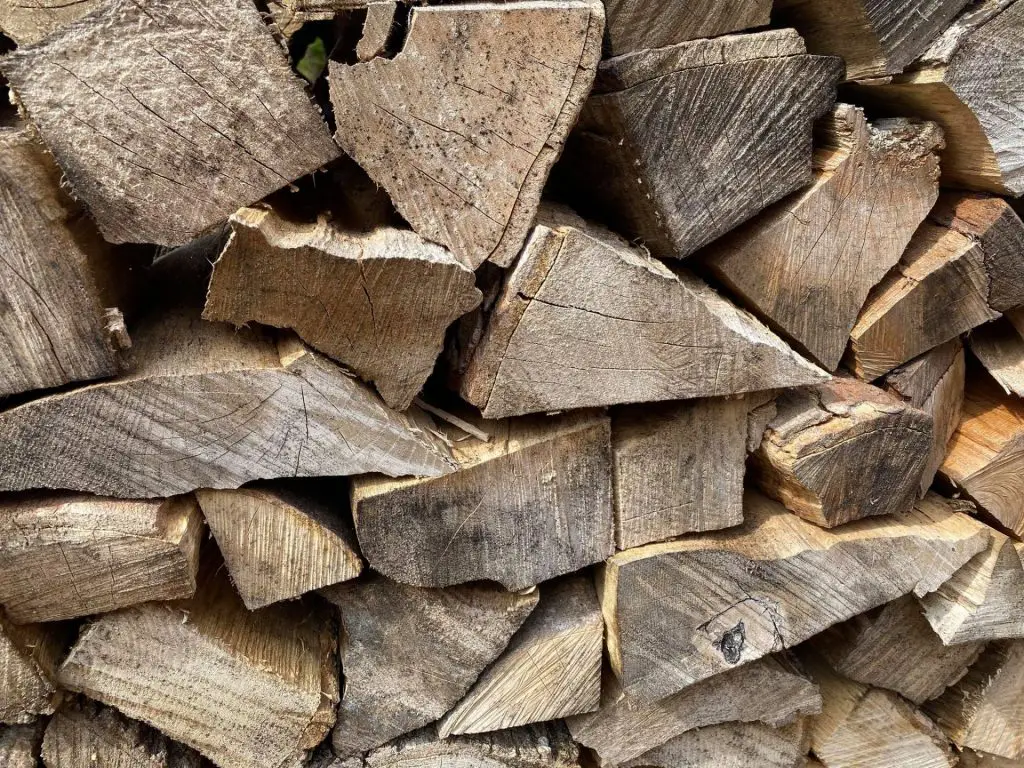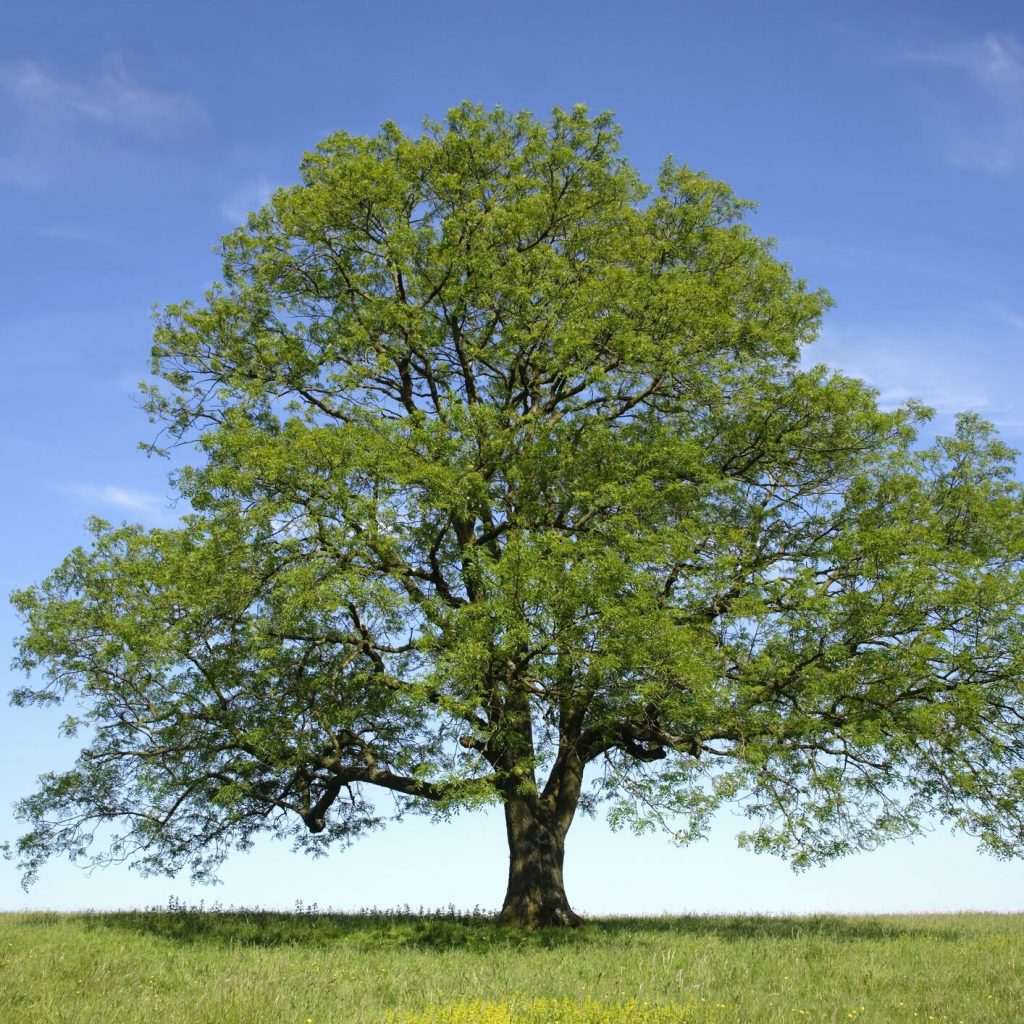Ash firewood is popular throughout North America because of its availability, high heat production, low smoke generation, and quick seasoning time. Its only disadvantage is that it can be moderately difficult to split, especially the larger diameter rounds with knots in the wood. I am a big fan of using ash wood as a base for my stockpile and throw in some more fragrant species such as hickory or pecan to generate a pleasant aroma, particularly for indoor heating.
Ash is ideal firewood for indoor and outdoor heating, and its high BTU means you don’t need to store as many cords as you do with softwoods.
Table of Contents
Summary
- Heat Production: 20-24 million BTU/cord
- Weight: 4000 lb/cord green
- Seasoning Time: 6-12 months
- Splitting Difficulty: Low-Moderate
- Sap Content: Low
- Smoke: Low
- Smell: Minimal, Mild
Overall, ash is excellent as firewood. It ticks all the boxes regarding heat production, smoke generation, and high density. It even has a shorter seasoning time than some other high-quality firewood such as oak or maple.
However, it does still have some disadvantages. I do think that it is more difficult to split than oak. This is due to the thick diameter trunk that has knots present throughout as branches shoot off in many directions. Ash trees are huge, so if you intend to process an entire tree at once, you should consider using a log splitter.
Ash wood also lacks much of a smoke smell. This can be an advantage and a disadvantage. I love the smell of fragrant wood smoke like hickory or cherry, but ash is very mild. It isn’t a wood I would ever use for smoking meat.

Heat Production
Ash wood has a high heat production just outside the top-tier woods like oak or maple. There are several ash species, the most common being green and white. They do tend to have differences in their heat production:
- Green Ash – 20 million BTU/cord
- White Ash – 24 million BTU/cord
This high heat production makes ash an ideal wood for building your winter stockpile. A single tree can provide a lot of wood, and its high density means that you don’t need as many cords as you would with pine or cedar. I think ash is great firewood to use as a base load and will happily use it.
Smoke Production
The smoke generation of ash is low. This is especially true if it is correctly seasoned. Seasoning allows the moisture and sap to leave the wood, leaving just the carbon behind for combustion. Thanks to the short seasoning time of ash, it is unlikely that you will be tempted to burn green wood, but I always recommend avoiding unseasoned lumber whenever possible.
The subtle smell of ash wood, combined with its low smoke production, makes it the ideal firewood for anyone sensitive to strong scents, particularly indoors with poorer ventilation.
Seasoning Time
Ash is relatively quick to season, taking just 6 to 12 months. This is considered fast for a hardwood and is one of its significant advantages over oak as firewood. This means that you can harvest and stockpile your firewood within the same year you use it. This is particularly handy to top up your firewood pile if you are worried that you haven’t prepared enough in time. It is also widely available so it shouldn’t be difficult to find.
Always ensure your firewood is sufficiently seasoned with less than 20% moisture to minimize any creosote buildup and smoke generation.
I personally recommend this General Tools Moisture Meter. It allows you to accurately gauge how wet your firewood is and whether it is sufficiently seasoned. Over time you can also see how quickly the moisture is dropping and how much longer you need to keep your firewood dropping until it is seasoned and ready to burn.
Press the sharp pins into the wood and you will quickly see the readout show the moisture ranging from 5% to 50%. It also has a Low/Mid/High indication depending on whether the wood is dry enough, so you don’t need to remember the actual values.

Burning Smell
Ash wood has a mild, neutral smell. This can be classed as either an advantage or a disadvantage. If you are sensitive to strong smells and want to heat your home with wood but don’t want it to smell like BBQ for the next three months, then ash is ideal.
However, if you are looking for a nice smelling firewood to smoke your food, then ash is a wood I would avoid.
I personally prefer the more fragrant woods for heating my home or campsite. A big tip for using ash is to use it as your base and then add a single log of cherry or apple wood to add the fragrance you are looking for.
Creosote Buildup
Creosote is a black soot buildup that occurs when the wood isn’t burned completely. This buildup can block your chimney and, in the worst-case scenario, can cause chimney fires. Creosote is most commonly found in softwoods like pine or when burning green firewood. All woods produce creosote, but ash doesn’t produce significant amounts. However, I always recommend seasoning it correctly to minimize this risk.
You should always get your chimney cleaned annually, even if you exclusively use low creosote firewood such as ash. This will completely eliminate any dangerous fire risks.
Splitting
Ash is a low to moderately tricky wood to split. They are more difficult to split than oak, and because of their large size, it can take a lot of elbow grease to process an entire tree. If you start splitting an ash tree and notice plenty of knots, I would strongly recommend bringing in a log splitter to help out.
Ash trees also don’t grow straight like oak and can have lots of knots from their numerous branches. They also have large diameter trunks, meaning you need more axes to split swings.
The moderate difficulty in splitting is one of ash’s few weaknesses as a firewood.
Different Types/Species
There are at least 16 different species of Ash tree, but there are two most common varieties – the green and the white.
Green Ash
Green ash trees are great shade trees and can live for up to 100 years. They are hardy with broad, deep root systems. Green ash has a lower BTU than white ash, but I find it easier to split.
- Heat Production: 20 million BTU/cord
- Height: 50 to 60 feet
White Ash
White ash trees grow higher than green ash and are often used in public places because of their wide span and colorful foliage in the fall. White ash is more popular than green ash, and the wood is also used commercially. In my experience, it is more challenging to split from rounds into logs.
- Heat Production: 24 million BTU/cord
- Height: 50 to 80 feet

Comparison to Other Woods
Here, I’ve taken some of the most popular firewoods to burn indoors and compared them to Ash firewood.
Ash is of excellent quality with great heat production, minimal smoke generation, and a reasonable seasoning time. Its only downside is that it can be difficult to split in large rounds and knotty sections, and it doesn’t have the pleasant smell of a Hickory. Ash is a great base to build your firewood stockpile from that you can supplement with some apple or cherry for the scent.
| Firewood | Million BTU/Cord (source) | Ease of Splitting | Coals | Overall Quality |
| Green Ash | 20 | Easy | Good | Excellent |
| Maple | 25 | Easy | Excellent | Excellent |
| Bur Oak | 26 | Easy | Good | Excellent |
| Ash | 20-24 | Easy to Moderate | Good | Excellent |
Ash is native to North America, making it much more readily available than alternatives like apple firewood. The trees are also wide and tall, giving a large firewood yield per tree. These logistics mean that ash is common, popular, and effective.
FAQs
Can you burn Ash wood in a fire pit?
Ash is well suited to burn in a fire pit because of its high heat production. Although it is slightly lower than oak or black locust, it is still excellent and will generate plenty of coals for cooking. It can be difficult to light, so you may need some pine to use as kindling.
Can you burn Ash wood in a wood stove?
Ash is ideal for burning indoors because of its high heat production, low smoke generation, and mild smell. If you are worried about strong smells spreading throughout your house, I recommend using ash. It has a very mild scent and is better suited for burning in your home. The high heat production also means that you don’t need to stockpile or burn as many logs as you would with other options.
How much does Ash firewood cost to buy?
Ash firewood costs similar amounts to other hardwood, between $350 and $400 per cord. This depends on the time of year, location, and availability of ash trees.
Final Thoughts
Ash is a very popular firewood because of its high heat production, low smoke generation, and mild, neutral scent. I like to use it as a base wood for my stockpiles because it is widely available and produces good coals for cooking. I often will add another, more fragrant wood to get that smell I am looking for or smoking heat.
If you are looking for a wood to stockpile for winter that is suited for both indoors and outdoors, then pick ash wood.
